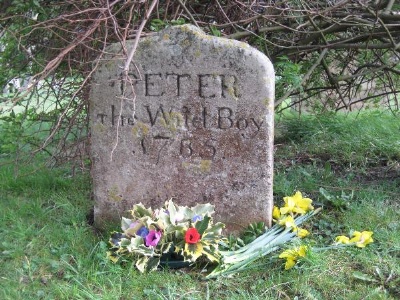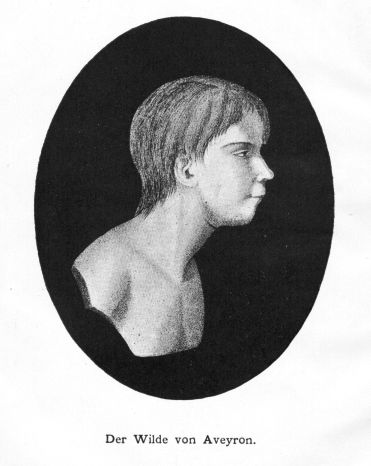“Monkey boys,” “wolf girls,” “gazelle boys,” and even an “ostrich boy;” they are all part of the lore of the feral children. Also known as “wild children,” these are children who have grown up with little or no human contact, and they are therefore unaware of human social behavior or language. Some are thought to have been raised by animals, some have reportedly fended for themselves in the wild, and others are victims of abuse, having grown up in the forced isolation of cages or basements.
A feral child (also, colloquially, wild child) is a human child who has lived isolated from human contact from a very young age, and has no (or little) experience of human care, loving or social behavior, and, crucially, of human language. Some feral children have been confined by people (usually their own parents); in some cases this child abandonment was due to the parents' rejection of a child's severe intellectual or physical impairment. Feral children may have experienced severe child abuse or trauma before being abandoned or running away. Others are alleged to have been brought up by animals; some are said to have lived in the wild on their own. Over one hundred cases of supposedly feral children are known.
1. Peter the Wild boy (1725-1785)

Peter was a mentally handicapped Hanoverian of unknown parentage, who in 1725 was found living wild in the woods near Hamelin, the town of Pied Piper legend. Living off the forest’s flora, he walked on all fours, behaved like an animal and could not be taught to speak.
Once found, he was brought to the Kingdom of Great Britain by order of George I, whose interest had been aroused in the unfortunate youth during a visit to his Hanover homeland. An extraordinary amount of curiosity and speculation concerning Peter was excited in London, and the craze was the subject of a biting satire by Jonathan Swift, and of another entitled The Most Wonderful Wonder that ever appeared to the Wonder of the British Nation, which has been attributed to Swift and John Arbuthnot; Daniel Defoe also wrote on the subject, and James Burnett, Lord Monboddo in his Origin and Progress of Language presents the “Idiot Peter” as an illustration of his theory of the evolution of the human species.
The Princess of Wales, Caroline of Ansbach, took an interest in Peter’s welfare after the initial public curiosity began to subside and in 1726 she arranged for Dr Arbuthnot to oversee his education. All efforts to teach him to speak, read or write failed, though he is said to have developed a love of music. After George I’s death in 1727 Peter was given in charge to a schoolmistress, Mrs King of Harrow and then to a farmer, James Fenn of Axter’s End farm, Northchurch, Hertfordshire, with an annual allowance provided by Queen Caroline. Peter remained at this farm until Fenn’s death when his care was taken over by Fenn’s brother, Thomas of Broadway farm. He was to live here for the remainder of his life only venturing further afield once.
In the late summer of 1751 Peter went missing from Broadway Farm and could not be traced. Advertisements were placed in newspapers offering a reward for his safe return. On 22 October 1751 a fire broke out in the parish of St Andrew’s in Norwich. As the fire spread, the local bridewell became engulfed in smoke and flame. The frightened inmates were hastily released and one aroused considerable curiosity on account of his remarkable appearance, excessively hirsute and strong, and the barely human sounds he uttered, which led some to describe him as an orang-utan. Some days later he was identified as Peter the Wild Boy, possibly through a description of him in the London Evening Post. He was returned to Thomas Fenn’s farm and had a special leather collar with his name and address made for him to wear in future should he ever stray again.
He lived to an advanced age, was seen by Lord Monboddo in 1782, and died in 1785.
2. The Wild Boy of Avyon

Unexplained Mysteries of Feral Children
A feral child (also, colloquially, wild child) is a human child who has lived isolated from human contact from a very young age, and has no (or little) experience of human care, loving or social behavior, and, crucially, of human language. Some feral children have been confined by people (usually their own parents); in some cases this child abandonment was due to the parents' rejection of a child's severe intellectual or physical impairment. Feral children may have experienced severe child abuse or trauma before being abandoned or running away. Others are alleged to have been brought up by animals; some are said to have lived in the wild on their own. Over one hundred cases of supposedly feral children are known.
1. Peter the Wild boy (1725-1785)

Peter was a mentally handicapped Hanoverian of unknown parentage, who in 1725 was found living wild in the woods near Hamelin, the town of Pied Piper legend. Living off the forest’s flora, he walked on all fours, behaved like an animal and could not be taught to speak.
Once found, he was brought to the Kingdom of Great Britain by order of George I, whose interest had been aroused in the unfortunate youth during a visit to his Hanover homeland. An extraordinary amount of curiosity and speculation concerning Peter was excited in London, and the craze was the subject of a biting satire by Jonathan Swift, and of another entitled The Most Wonderful Wonder that ever appeared to the Wonder of the British Nation, which has been attributed to Swift and John Arbuthnot; Daniel Defoe also wrote on the subject, and James Burnett, Lord Monboddo in his Origin and Progress of Language presents the “Idiot Peter” as an illustration of his theory of the evolution of the human species.
The Princess of Wales, Caroline of Ansbach, took an interest in Peter’s welfare after the initial public curiosity began to subside and in 1726 she arranged for Dr Arbuthnot to oversee his education. All efforts to teach him to speak, read or write failed, though he is said to have developed a love of music. After George I’s death in 1727 Peter was given in charge to a schoolmistress, Mrs King of Harrow and then to a farmer, James Fenn of Axter’s End farm, Northchurch, Hertfordshire, with an annual allowance provided by Queen Caroline. Peter remained at this farm until Fenn’s death when his care was taken over by Fenn’s brother, Thomas of Broadway farm. He was to live here for the remainder of his life only venturing further afield once.
In the late summer of 1751 Peter went missing from Broadway Farm and could not be traced. Advertisements were placed in newspapers offering a reward for his safe return. On 22 October 1751 a fire broke out in the parish of St Andrew’s in Norwich. As the fire spread, the local bridewell became engulfed in smoke and flame. The frightened inmates were hastily released and one aroused considerable curiosity on account of his remarkable appearance, excessively hirsute and strong, and the barely human sounds he uttered, which led some to describe him as an orang-utan. Some days later he was identified as Peter the Wild Boy, possibly through a description of him in the London Evening Post. He was returned to Thomas Fenn’s farm and had a special leather collar with his name and address made for him to wear in future should he ever stray again.
He lived to an advanced age, was seen by Lord Monboddo in 1782, and died in 1785.
2. The Wild Boy of Avyon


No comments:
Post a Comment